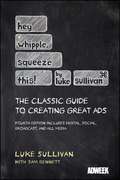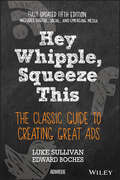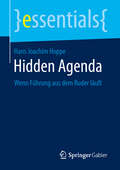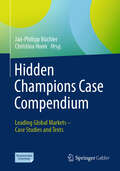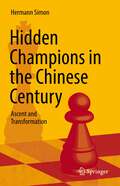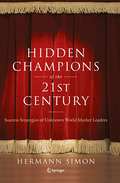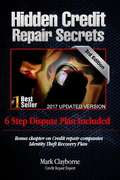- Table View
- List View
Hewlett-Packard: Culture in Changing Times
by James Weber Rakesh Khurana Michael BeerHP had been a highly successful and respected company for decades. It was well known for its company culture and management practices--the HP way--which emphasized both profits and people. Changing markets, strong competitors, and the growth of its computer business, however, battered the company in the mid-1990s. To turn things around, HP hired Carly Fiorina, the first outsider to lead the company. Describes Fiorina's strategy and the impact of decisions she made with respect to the acquisition of Compaq and HR policies on HP's venerable culture and performance.
Hewlett-Packard: Singapore (A)
by Dorothy Leonard-Barton George ThillIn the over 20 years since Hewlett-Packard (HP) set up a manufacturing site in Singapore to produce calculators, HP has invested managerial talent and resources in developing its licensor into a technology development partner. The case details the growth of high-volume manufacturing capabilities and the setting up of an R&D facility. Various projects are described in which Singapore contributed an increasing amount of skill, leading up to an abortive attempt to completely co-develop a new printer. Singapore now feels ready to develop a printer on its own for the Japanese market, and the case poses the question of whether or not it is ready to do so. There is also an issue of whether the developers understand the Japanese market well enough to proceed.
Hewlett-Packard: Singapore (B)
by Dorothy Leonard-Barton George ThillDiscusses the printer Hewlett-Packard has developed.
Hewlett-Packard: Singapore (C)
by Dorothy Leonard-Barton George ThillDiscusses the printer Hewlett-Packard has developed.
Hewlett-Packard: The Flight of the Kittyhawk (A)
by Clayton M. ChristensenHewlett-Packard decided that, to grow more rapidly, it needed to design a revolutionary disk drive product that would create an entirely new market or application for magnetic recording technology. The company followed most of the "rules" good managers follow in such situations: heavyweight project team, lots of senior management support, etc. But it still failed.
Hewlett-Packard: The Flight of the Kittyhawk (B)
by Clayton M. ChristensenAn abstract is not available for this product.
Hexion/Apollo's Courtship of Huntsman Corporation (A)
by Lena G. Goldberg Danielle V. HollandIn July 2007, after several failed attempts to acquire Huntsman Corporation, Hexion/Apollo prevailed in a bidding war for the company and signed a definitive merger agreement. Apollo had down bid Huntsman during previous attempts to acquire the company, and Huntsman was suspicious. That suspicion, coupled with Huntsman's leverage that resulted from a competitive bid situation, prompted and enabled Huntsman to negotiate seller friendly terms. For example, there was no financing contingency, and although the merger agreement contained both a material adverse effect (MAE) clause and a reverse termination fee, the potential damages if Hexion/Apollo breached the agreement were uncapped. As the credit markets deteriorated in late 2007 and into 2008 and Huntsman turned in disappointing financial results, the Huntsman deal no longer looked attractive to Hexion/Apollo. Hexion/Apollo wanted out. Would the material adverse change (MAC) clause in the merger agreement permit Hexion/Apollo to simply walk away? Even if the MAE clause were not applicable, could Hexion/Apollo walk away by paying the reverse termination fee? Or were potential damages uncapped?
Hexion/Apollo's Courtship of Huntsman Corporation (B)
by Lena G. Goldberg Danielle V. HollandTo be used with Hexion/Apollo's Courtship of Huntsman Corporation (A) 316-028.
Hey Whipple, Squeeze This: The Classic Guide to Creating Great Advertising
by Luke SullivanThe new edition of the book readers call the bible for advertising The sixth edition of Hey Whipple, Squeeze This offers a new take on the rapidly evolving industry of creative advertising. Creativity—while critical—is no longer enough to succeed. Updating all the classic creativity training from the first five editions, this updated version now provides the necessary tools to navigate the field’s changing technical and social media landscapes. From learning how to tell brand stories to creating content for Instagram, YouTube, and TikTok, Whipple will help sharpen your writing chops, enhance your creativity, and raise the level of your work whether you’re new to the business or a practicing professional. In this fully updated edition, you’ll explore: How to employ the traditional concepting techniques today’s creatives use, as well as new developments in applied creativity and inquiry-based innovation. How to use emerging technologies and the different technical structures of social media platforms to bring brand stories to life. How to go 180˚ against common sense for ideas that have the potential of becoming viral. How to create the kind of portfolio that will get you a job in the industry.
Hey! I'm The Manager... Why Aren't You Listening To Me?: A Field Guide For Managing People
by Steve FarnerManagement expert Steve Farner, Ph. D. , uses his practical knowledge and years of experience to create a thorough guide for managing people in today's work environment. This comprehensive and entertaining guide contains true-life examples from Farner's time with his family's candy and grocery wholesale distribution business. He explains that management is not just about delegation of work, it is about understanding what makes people perform at their highest potential. Contains valuable resource lists and an index.
Hey, Waitress! The USA from the Other Side of the Tray
by Alison OwingsContaining lively, personal portraits of waitresses from many different walks of life, this book is the first of its kind to show the intimate, illuminating, and often shocking behind-the-scenes stories of waitresses' daily shifts and daily lives.
Hey, Whipple, Squeeze This
by Sam Bennett Luke SullivanThe classic (and irreverent) bestselling guide to creating great advertisingHey Whipple, Squeeze This has inspired a generation of ad students, copywriters, and young creatives to make their mark in the industry. But students need new guidance to ply their craft now in the digital world. This new fourth edition explains how to bring brand stories into interactive, dynamic places online, in addition to traditional television, radio, print, and outdoor ads.Creativity is still king, but this new edition contains:Important new chapters and updates that bring Whipple into the new digital worldNew content and examples for how to use social media and other emerging platformsIllustrate what's changing in the new world of advertising--and what isn'tHey Whipple, Squeeze This! will help sharpen your writing chops, unleash your creativity, and help raise the level of your work from hack to master craftsman.
Hey, Whipple, Squeeze This: The Classic Guide to Creating Great Ads (Adweek Magazine Ser. #Vol. 5)
by Luke SullivanThe classic guide to creating great advertising now covers all media: Digital, Social, and Traditional Hey Whipple, Squeeze This has helped generations of young creatives make their mark in the field. From starting out and getting work, to building successful campaigns, you gain a real-world perspective on what it means to be great in a fast-moving, sometimes harsh industry. You'll learn how to tell brand stories and create brand experiences online and in traditional media outlets, and you'll learn more about the value of authenticity, simplicity, storytelling, and conflict. Advertising is in the midst of a massive upheaval, and while creativity is still king, it's not nearly enough. This book is an essential resource for advertising professionals who need up-to-date digital skills to reach the modern consumer. Turn great ideas into successful campaigns Work effectively in all media channels Avoid the kill shots that will sink any campaign Protect your work Succeed without selling out Today's consumer has seen it all, and they're less likely than ever to even notice your masterpiece of art and copy, let alone internalize it. Your job is to craft a piece that rises out of the noise to make an impact. Hey Whipple, Squeeze This provides the knowledge to create impressive, compelling work.
HgCapital and the Visma Transaction (A)
by Paul A. Gompers Karol Misztal Joris Van GoolThis case concerns the negotiations of a deal by HgCapital, a UK-based private equity firm, to buy Visma, ASA, a Norwegian software company. Visma has received an offer from Sage Group, a strategic acquirer. HgCapital must determine if it wants to bid and how to outbid a potential strategic acquirer. The case concerns bidding and negotiations strategies as well as deal structuring issues. In particular, the cross border nature of the investment, a UK firm investing in Norway, leads to a number of financing issues related to raising the debt for the LBO. The case provides an opportunity to role play both the PE fund perspective and the potential target.
HgCapital and the Visma Transaction (B-1): Nic Humphries
by Paul A. Gompers Karol Misztal Joris Van GoolCase
HgCapital and the Visma Transaction (B-2): Oystein Moan
by Paul A. Gompers Karol Misztal Joris Van GoolCase
Hidden Agenda: Wenn Führung aus dem Ruder läuft (essentials)
by Hans Joachim HoppeDieses Buch gibt aus der Führungserfahrung des Autors ausgewählte „Klassiker“ zu scheitern in kompakter Form wieder und soll Führungskräften die Möglichkeit geben, aus Fehlern anderer zu lernen. Entscheidungen zu treffen, war noch nie so riskant wie heute und Fehlentscheidungen bzw. Führungsfehler können schnell den Kopf kosten. Kommen dann noch verdeckte Absichten ins Spiel, die „Hidden Agenda“, wird es brandgefährlich. Für die Mitarbeiter ist das, was sich „oben“ abspielt, in der Regel nicht zu durchschauen. Es bleibt ihnen nichts anderes übrig, als dem Management (blind) zu vertrauen. Dieses Buch ersetzt kein Führungstraining, doch für Manager, die sich zumindest regelmäßig reflektieren, soll es Hilfestellung und Anregung sein.
Hidden Champions Case Compendium: Leading Global Markets – Case Studies and Texts
by Jan-Philipp Büchler Christina HoonThis textbook provides an in-depth portfolio of case studies of globally operating and market leading medium-sized companies, mostly based in Germany. Students in the field of strategic management, family business management, information technology, and engineering may comprehensively explore the success factors of these hidden champions. Assignments and discussion sections help to dive deeper into the topics of innovation, internationalization, and leadership. Practitioners may gain valuable insights into growth trajectories and strategic decisions for achieving and sustaining market leadership. All case studies have been developed in direct cooperation with the companies and tested in teaching.
Hidden Champions in CEE and Turkey
by Peter Mckiernan Danica PurgThis book presents hidden champions in Central and Eastern Europe (CEE) and Turkey that have been studied as a joint project between CEEMAN and IEDC-Bled School of Management, Slovenia. This is an outcome of extensive research undertaken by over 30 researchers and covers 15 countries from Russia to Albania; covering many contexts, political systems, cultures and infrastructures. The reader is provided with a detailed introduction to the concept of hidden champions and describes the cases studied in this project. This book is an invaluable resource providing a culmination of interdisciplinary, cross-study chapters ranging from leadership to performance drivers; from organization to culture and governance; from innovativeness to sustainability and further to the financial aspects of hidden champions business models. These meta level chapters are followed by 15 country-specific chapters which provide an overview of each country's history, economic indicators and vignettes of the cases involved in this study.
Hidden Champions in Dynamically Changing Societies: Critical Success Factors for Market Leadership
by Danica Purg Alenka Braček LalićHidden champions are highly successful small and medium-sized companies that are global leaders in terms of market share in their respective niches. Presenting the outcomes of an in-depth, multinational study on hidden champions in Central, Eastern, and Southeast Europe, Russia, China, Mongolia and Turkey, this book provides essential insights into the critical drivers of success, market leadership positions, competitive advantage, and core lessons learned on the road to business prosperity. It also addresses development needs in connection with management, financing and the regulatory environment, which can in turn be used to create recommendations for various stakeholders (e.g. governments, financial institutions, management development institutions) in order to support hidden champions in their further growth and business success.
Hidden Champions in the Chinese Century: Ascent and Transformation
by Hermann Simon“Hidden Champions” are medium-sized, unknown companies with annual revenues under $5 billion that have quietly, under the radar, become world market leaders in their respective industries. In this new instalment to his worldwide bestselling Hidden Champions volumes, Hermann Simon takes readers on in-depth exploration of the ever changing operating conditions and the greater uncertainty and volatility that defines the global business sphere over the next ten years. In particular, in this book he focuses on China’s continued impact on the business world since its rise in the global business and economic sphere over recent decades. In this regard, Dr. Simon shows the reader how the current status evolved, and then offers concrete and actionable recommendations. New driving forces such as digitalization, business ecosystems and sustainability receive special attention. While the main focus is on companies in German-speaking countries as they comprise 56 percent of the world’s Hidden Champions, the success factors mentioned in this book can be applied globally to mid-sized companies in other regions as they strive to become global market leaders. Whether a company is a “Hidden Champion”, aspires to be one, or wants to emulate their success model, Dr. Simon’s new book provides essential food for thought as executives and managers chart their course into the future.
Hidden Champions of the Twenty-First Century
by Hermann SimonWhat do Tetra aquarium supplies, Elector-Nite sensors, and Nissha touch panels have in common? They are typical "hidden champions", medium-sized, unknown companies that have quietly, under the radar, become world market leaders in their respective industries. Going deep inside more than a thousand hidden champions around the world, Hermann Simon reveals the common patterns, behaviors, and approaches that make these secretive companies successful by bucking today's management fads, and pursuing such common-sense strategies as focusing on core capabilities, establishing long-term relationships with customers, innovating continuously, rewarding employees for performance, and developing a global presence. In turbulent economic times, the hidden champions represent an antidote to the short-sighted and excessive practices that have brought many corporate giants crashing down, and may well serve as the new role models for sustainable economic growth.
Hidden Costs, Values Lost: Uninsurance in America
by Institute of Medicine of the National AcademiesHidden Cost, Value Lost, the fifth of a series of six books on the consequences of uninsurance in the United States, illustrates some of the economic and social losses to the country of maintaining so many people without health insurance. The book explores the potential economic and societal benefits that could be realized if everyone had health insurance on a continuous basis, as people over age 65 currently do with Medicare. Hidden Costs, Value Lost concludes that the estimated benefits across society in health years of life gained by providing the uninsured with the kind and amount of health services that the insured use, are likely greater than the additional social costs of doing so. The potential economic value to be gained in better health outcomes from uninterrupted coverage for all Americans is estimated to be between $65 and $130 billion each year.
Hidden Credit Repair Secrets: How I Bounced Back From Bankruptcy,
by Mark ClayborneUnderstanding Credit Reports, The Dispute Process, When the Credit Bureaus Won't Fix My Credit Report, How to Remove the ""Eleven Killers"" from My Credit Report, How to Repair My Credit with Debt Settlement Techniques, How to Repair My Credit Using Credit Repair Companies, Suing the Credit Bureaus to Get Them to Remove Negative <P><P> Information from My Credit Report, Rebuilding My Credit from the Ground Up, Raising My Credit Score, Can I Stop the Collection Agencies in Their Tracks, How Can I Protect My Good Credit During a Divorce, Should I File for Bankruptcy, How Do I Recover From Identity Theft.
Hidden Debt: Solutions to Avert the Next Financial Crisis in South Asia (South Asia Development Matters)
by Martin MeleckyThe COVID-19 crisis, which has sent economies in South Asia and around the world into a deep recession, has highlighted South Asia’s rising debt levels and sizable hidden liabilities. State-owned enterprises, state-owned commercial banks, and public-private partnerships have been at the center of the rising debt wave and the latest pandemic response. Historically,South Asia has relied on these direct public interventions more than other regions. The interventions have helped governments tackle key development challenges and rapidly deliver relief measures during crises. However, because of their inefficiencies and weak governance, the interventions are also a significant source of public indebtedness and macrofinancial risks. Hidden Debt examines the trade-off between tackling development challenges through direct state presence in the market and avoiding unsustainable debt due to economic inefficiencies of such off†“balance sheet operations, which greatly leverage public capital. The study recommends a reform agenda based on the four interrelated principles of purpose, incentives, transparency, and accountability (PITA). The reforms can mitigate the risks that off†“balance sheet operations will become the source of the next financial crisis in South Asia.




